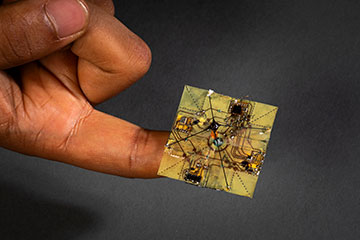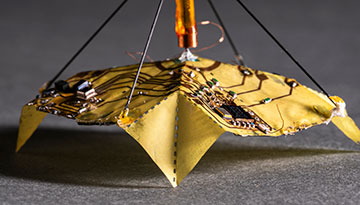
Researchers at the University of Washington, USA, developed small robotic devices that can change how they move through the air by "snapping" into a folded position during their descent. [Image: Vicente Arroyos, Kyle Johnson, Vikram Iyer / University of Washington]
In some plants, the process of seeds or fruit moving from one location to another, known as dispersal, occurs through passive means. Wind dispersal is especially common—for example, winged maple seeds autorotate and generate lift as they fall.
Inspired by both nature and origami, researchers at the University of Washington, USA, have developed small robotic devices that can change shape in midair to control their descent (Sci. Robot., doi: 10.1126/scirobotics.adg4276). The microfliers are powered by an array of lightweight thin-film solar cells that eliminate the need for heavy, bulky batteries.
Changing shape, changing descent
When equipped with onboard sensors, wind-dispersed microfliers could serve as a large-scale wireless sensor network for the purpose of environmental monitoring. They may be employed to survey temperature, humidity and other conditions while soaring.
Vikram Iyer and his colleagues aimed to create miniaturized, battery-free microfliers that behave similarly to seeds and leaves in terms of passive dispersal, yet retain some user control. By incorporating concepts from the art of paper folding, they designed a robotic device that uses a solar-powered actuator to switch from a tumbling descent that disperses outward to a straight-down, stable descent.

Each device has an onboard battery-free actuator, a solar power–harvesting circuit and controller to trigger the shape changes in midair. [Image: Vicente Arroyos, Kyle Johnson, Vikram Iyer / University of Washington]
“While prototyping and exploring the properties of origami structures, we discovered that a small change in shape can have a dramatic effect on their falling behavior,” said study author Iyer, a computer science and engineering professor at the University of Washington. “These fliers open up a new design space of robotic, shape-changing fliers and create a new aerial platform for wireless sensing.”
Outdoor evaluation
The microfliers consist of an origami structure based on the Miura-ori, which is a method of folding a flat surface into a smaller area. A thin-film solar cell array provides power to an onboard microcontroller and electromagnetic actuator that can electronically switch between the robot’s two states in midair. The switching can occur at a programmed time or altitude (based on a pressure sensor) or when prompted by a radio signal sent to the onboard receiver.
In an outdoor field evaluation, the researchers released the origami microfliers, weighing only 414 mg, from a drone. The devices were able to successfully change shape and traveled up to 98 m in a light breeze. After landing, an onboard temperature and pressure sensor wirelessly transmitted data via Bluetooth to a remote receiver up to 60 m away.
“These microfliers also present a new platform to deploy miniaturized optical sensors in the air,” said Iyer. “Future versions could carry cameras or things like optical gas or particulate sensors to detect air pollution and more.”
